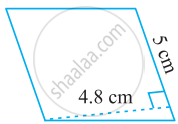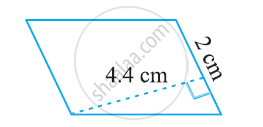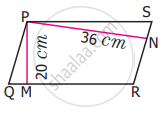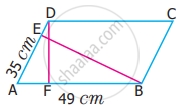Advertisements
Advertisements
प्रश्न
If the sides of a parallelogram are increased to twice its original lengths, how much will the perimeter of the new parallelogram?
विकल्प
1.5 times
2 times
3 times
4 times
उत्तर
2 times
Explanation:
Let the length and breadth of the parallelogram be l and b, respectively.
Then, perimeter = 2(1 + b) ......[∵ Perimeter of parallelogram = 2 × (length + breadth)]
If both sides are increased twice, then new length and breadth will be 21 and 2b, respectively.
Now, new perimeter = 2(21 + 2b) = 2 × 2(l + b) = 2 times of original perimeter.
Hence, the perimeter of parallelogram will be increased 2 times.
APPEARS IN
संबंधित प्रश्न
Find the area of the following parallelogram:

Find the area of the following parallelogram:

Find the area of the following parallelogram:

A parallelogram has sides of 20 cm and 30 cm. If the distance between its shorter sides is 15 cm; find the distance between the longer sides.
Find the missing values.
| Base | Height | Area |
| 8 cm | 56 sq.m |
Janaki has a piece of fabric in the shape of a parallelogram. Its height is 12 m and its base is 18 m. She cuts the fabric into four equal parallelograms by cutting the parallel sides through its mid-points. Find the area of each new parallelogram
In a parallelogram the base is three times its height. If the height is 8 cm then the area is
The base of the parallelogram is 16 cm and the height is 7 cm less than its base. Find the area of the parallelogram
In a parallelogram PQRS (See the diagram) PM and PN are the heights corresponding to the sides QR and RS respectively. If the area of the parallelogram is 900 sq.cm and the length of PM and PN are 20 cm and 36 cm respectively, find the length of the sides QR and SR
The area of the parallelogram ABCD is 1470 sq.cm. If AB = 49 cm and AD = 35 cm then, find the height, DF and BE
